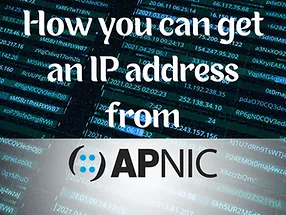Asia-Pacific Network Information Centre (APNIC) manages the distribution of IP addresses and Autonomous System (AS) numbers within the Asia-Pacific region. They ensure that Internet number resources are distributed fairly and efficiently to network operators, Internet service providers (ISPs), and other organizations that require them.
APNIC assigns blocks of IP addresses to their members, including IPv6 blocks.
What is an IPv6?
IPv6 is the latest version of the Internet Protocol, the previous one being IPv4. IPv4 had a limited number of unique addresses, which led to the depletion of available addresses. IPv6 solves this problem by providing a significantly larger address space.
How to Get an IPv6 Block from APNIC
You need to be an APNIC member in order to apply for an IP block. If you are not a member yet, you can access the registration page here.
If you are already a member, you may proceed with the steps for requesting IP blocks. There are different steps for requesting a IPv6 block from APNIC, depending on your membership criteria or request volume.
You Currently Have an APNIC IPv4 Block
Members who currently have IPv4 addresses will automatically qualify for IPv6 addresses of an appropriate size. If you have been allocated IPv4 addresses, you are eligible for a /32 block of IPv6 addresses.
If you have been assigned IPv4 addresses, you are eligible for a /48 block of IPv6 addresses. You no longer need to pay any fees when applying for additional resources.
You Don’t Have IPv4 Yet or Your Need Exceeds the Minimum Allocation Size
If you don’t have IPv4 addresses or require more than the minimum allocation size, you will need to meet certain criteria:
– You must be an LIR (Local Internet Registry).
– You cannot be an end site.
– You must have a plan to announce IPv6 within two years.
You will need to pay the annual membership fee and a non-refundable IP resource application fee. You may refer to this page to estimate your costs.
If you already have IPv4 addresses and are applying for a larger IPv6 allocation, you will not need to pay any resource application fees.
In addition to these criteria, an organization must meet at least one of the following:
– Have a plan to make at least 200 assignments to other organizations within two years.
– Be an existing LIR with IPv4 allocations from APNIC or an NIR (National Internet Registry).
You must have plans to make IPv6 assignments or sub-allocations within two years.
If you need a /32 or larger allocation, you must meet the following criteria:
– Your organization cannot be an end site.
– You must provide comprehensive documentation of their planned IPv6 infrastructure that
necessitates a larger allocation.
– Alternatively, you must provide information about your existing IPv4 infrastructure and
customer base, along with your intention to transition some of your IPv4 customers to IPv6
within two years.
If you are doing experimental allocations:
You must document your experiment in an Experimental RFC or an alternative publication approved by APNIC. You can learn more about Experimental RFC here.



